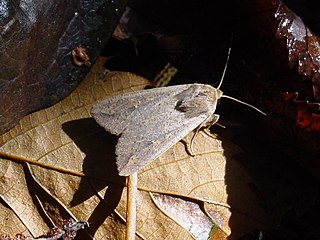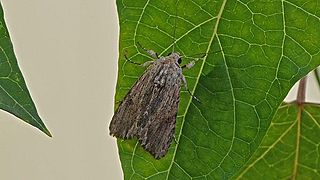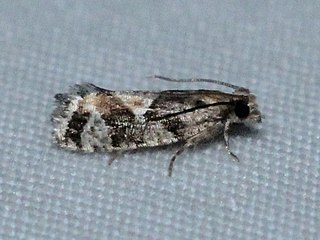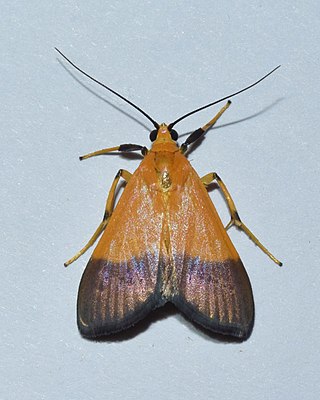
Helicoverpa zea, commonly known as the corn earworm, is a species in the family Noctuidae. The larva of the moth Helicoverpa zea is a major agricultural pest. Since it is polyphagous during the larval stage, the species has been given many different common names, including the cotton bollworm and the tomato fruitworm. It also consumes a wide variety of other crops.

The Pyralidae, commonly called pyralid moths, snout moths or grass moths, are a family of Lepidoptera in the ditrysian superfamily Pyraloidea. In many classifications, the grass moths (Crambidae) are included in the Pyralidae as a subfamily, making the combined group one of the largest families in the Lepidoptera. The latest review by Eugene G. Munroe and Maria Alma Solis retain the Crambidae as a full family of Pyraloidea.

The codling moth is a member of the Lepidopteran family Tortricidae. They are major pests to agricultural crops, mainly fruits such as apples and pears, and a codling moth larva is often called an "apple worm". Because the larvae are not able to feed on leaves, they are highly dependent on fruits as a food source and thus have a significant impact on crops. The caterpillars bore into fruit and stop it from growing, which leads to premature ripening. Various means of control, including chemical, biological, and preventive, have been implemented. This moth has a widespread distribution, being found on six continents. Adaptive behavior such as diapause and multiple generations per breeding season have allowed this moth to persist even during years of bad climatic conditions.

The African armyworm, also called okalombo, kommandowurm, or nutgrass armyworm, is a species of moth of the family Noctuidae. The larvae often exhibit marching behavior when traveling to feeding sites, leading to the common name "armyworm". The caterpillars exhibit density-dependent polyphenism where larvae raised in isolation are green, while those raised in groups are black. These phases are termed solitaria and gregaria, respectively. Gregaria caterpillars are considered very deleterious pests, capable of destroying entire crops in a matter of weeks. The larvae feed on all types of grasses, early stages of cereal crops, sugarcane, and occasionally on coconut. The solitaria caterpillars are less active and undergo much slower development. The species is commonly found in Africa, but can also be seen in Yemen, some Pacific islands, and parts of Australia. African armyworm outbreaks tend to be devastating for farmland and pasture in these areas, with the highest-density outbreaks occurring during the rainy season after periods of prolonged drought. During the long dry seasons ("off-season"), the population densities are very low and no outbreaks are seen.

Agrotis ipsilon, the dark sword-grass, ipsilon dart, black cutworm, greasy cutworm or floodplain cutworm, is a small noctuid moth found worldwide. The moth gets its scientific name from black markings on its forewings shaped like the letter "Y" or the Greek letter upsilon. The larvae are known as "cutworms" because they cut plants and other crops. The larvae are serious agricultural pests and feed on nearly all varieties of vegetables and many important grains.

The genus Crambus includes around 155 species of moths in the family Crambidae, distributed globally. The adult stages are called crambid snout moths, while the larvae of Crambus and the related genus Herpetogramma are the sod webworms, which can damage grasses.

Mythimna unipuncta, the true armyworm moth, white-speck moth, common armyworm, or rice armyworm, is a species of moth in the family Noctuidae. The species was first described by Adrian Hardy Haworth in 1809. Mythimna unipuncta occurs in most of North America south of the Arctic, as well as parts of South America, Europe, Africa, and Asia. Although thought to be Neotropical in origin, it has been introduced elsewhere, and is often regarded as an agricultural pest. They are known as armyworms because the caterpillars move in lines as a massive group, like an army, from field to field, damaging crops.

Peridroma saucia, the pearly underwing or variegated cutworm, is a moth of the family Noctuidae. The species was first described by Jacob Hübner in 1808. It is found in North and South America, Europe, Asia and Africa. The variegated cutworm feeds on many plants, especially common fruits and vegetables. The moth undergoes two to four generations per year. The development of the moth slows in colder temperatures, indicative of its migratory nature. All stages of the life cycle have a developmental threshold for temperature. The moth is known to migrate to the northern regions during warmer months, returning to the southern regions when the climate becomes colder.

Spoladea recurvalis, the beet webworm moth or Hawaiian beet webworm moth, is a species of moth of the family Crambidae. It is found worldwide, but mainly in the tropics.

Eriogaster lanestris, commonly known as the small eggar, is a moth of the family Lasiocampidae that is found across the Palearctic. Unlike many other members of the Lasiocampidae, the small eggar is a social insect. Historically, only eusocial insects like ants, bees, and termites were thought to exhibit complex social organization and communication systems. However, research since the late 20th century has found that E. lanestris, among a number of other phylogenetically related moth and butterfly species, demonstrates social behaviors as well. Larvae spend nearly their entire development in colonies of about 200 individuals, and this grouped social structure offers a number of benefits, from thermoregulation to increased foraging success.

Herpetogramma is a genus of moths in the family Crambidae described by Julius Lederer in 1863. It currently comprises 106 species that are found in North America, Eurasia, Australia, New Zealand, Central and South America. Of the few species where host plants are known, the larvae mostly feed on grasses.

Spodoptera eridania is a moth that is known to be a pest. They are one of the most important defoliators in the tropical and subtropical regions of the western hemisphere that feed heavily on plants while they are young, often resulting in skeleton leaves on their food plants. They are also heavy feeders on tomato in Florida. There is a lot of development in producing pesticides against the S. eridania, specifically a neem-based pesticide that can result in smaller and prolonged development. The wingspan is 33–38 mm. Adults are on wing year-round. The larvae feed on various weeds but prefer Amaranthus species and Phytolacca americana.

Zeiraphera canadensis, the spruce bud moth, is a moth of the family Tortricidae. It is a small brown moth mainly found in North America, specifically New Brunswick, Quebec, and the north-eastern United States. The adult moth flutters quickly, and stays low among trees during the day and higher above tree cover after sunset. The spruce bud moth relies primarily on the white spruce tree as a host plant. Both male and female spruce bud moths mate multiply, however males have the ability to secrete accessory gland proteins that prevent female re-mating. The moth is univoltine, meaning only one generation hatches per year, and its eggs overwinter from July to May. The species Z. ratzeburgiana is very similar to Z. canadensis and can only be distinguished by the presence of an anal comb in Z. canadensis.

Arsenura armida, the giant silk moth, is a moth of the family Saturniidae. It is found mainly in South and Central America, from Mexico to Bolivia, and Ecuador to south-eastern Brazil. It was first described by Pieter Cramer in 1779.
Ithome concolorella, the kiawe flower moth, is a species of moth of the family Cosmopterigidae. It was first described by Vactor Tousey Chambers in 1875. It is found in the southern United States, including Texas, southern Arizona and Florida. It is an introduced species in Hawaii, where it has been recorded from Kauai, Oahu, Maui, Hawaii and Molokai.

Chilo suppressalis, the Asiatic rice borer or striped rice stemborer, is a moth of the family Crambidae. It is a widespread species, known from Iran, India, Sri Lanka, China, eastern Asia, Japan, Taiwan, Malaysia to the Pacific.

Conopomorpha flueggella is a moth of the family Gracillariidae. It is known from Tianjin, China.

Herpetogramma aeglealis, commonly known as the serpentine webworm moth, is a species of moth in the family Crambidae. It was first described by Francis Walker in 1859 and is found in eastern North America.

Herpetogramma phaeopteralis, commonly known as the dark sod webworm, is a species of moth in the family Crambidae. It was described by Achille Guenée in 1854.

Ulopeza conigeralis is a species of moth in the family Crambidae. It was described by Philipp Christoph Zeller in 1852. It is found in Cameroon, the Republic of the Congo, the Democratic Republic of the Congo, Equatorial Guinea, Ethiopia, Ghana, Ivory Coast, Mali, Nigeria, Sierra Leone, South Africa and Zambia.



















